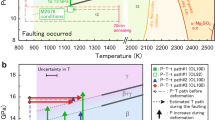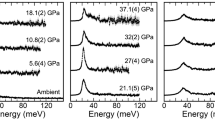Abstract
The mineral olivine dominates the composition of the Earth's upper mantle and hence controls its mechanical behaviour and seismic anisotropy. Experiments at high temperature and moderate pressure, and extensive data on naturally deformed mantle rocks, have led to the conclusion that olivine at upper-mantle conditions deforms essentially by dislocation creep with dominant [100] slip. The resulting crystal preferred orientation has been used extensively to explain the strong seismic anisotropy observed down to 250 km depth1,2,3,4. The rapid decrease of anisotropy below this depth has been interpreted as marking the transition from dislocation to diffusion creep in the upper mantle5. But new high-pressure experiments suggest that dislocation creep also dominates in the lower part of the upper mantle, but with a different slip direction. Here we show that this high-pressure dislocation creep produces crystal preferred orientations resulting in extremely low seismic anisotropy, consistent with seismological observations below 250 km depth. These results raise new questions about the mechanical state of the lower part of the upper mantle and its coupling with layers both above and below.
This is a preview of subscription content, access via your institution
Access options
Subscribe to this journal
Receive 51 print issues and online access
$199.00 per year
only $3.90 per issue
Buy this article
- Purchase on Springer Link
- Instant access to full article PDF
Prices may be subject to local taxes which are calculated during checkout



Similar content being viewed by others
References
Montagner, J.-P. Seismic anisotropy of the Pacific Ocean inferred from long-period surface waves dispersion. Phys. Earth Planet. Inter. 38, 28–50 (1985)
Cara, M. & Lévèque, J. L. Anisotropy of the asthenosphere: The higher mode data of the Pacific revisited. Geophys. Res. Lett. 15, 205–208 (1988)
Nishimura, C. E. & Forsyth, D. W. The anisotropic structure of the upper mantle in the Pacific. Geophys. J. 96, 203–230 (1989)
Montagner, J.-P. & Kennett, B. L. N. How to reconcile body-wave and normal-mode reference earth models. Geophys. J. Int. 125, 229–248 (1996)
Karato, S.-I. On the Lehman discontinuity. Geophys. Res. Lett. 19, 2255–2258 (1992)
Karato, S. I. & Rubie, D. C. Toward an experimental study of deep mantle rheology: a new multianvil sample assembly for deformation studies under high pressures and temperatures. J. Geophys. Res. 102, 20111–20122 (1997)
Cordier, P. & Rubie, D. C. Plastic deformation of minerals under extreme pressure using a multi-anvil apparatus. Mater. Sci. Eng. A 309–310, 38–43 (2001)
Durham, W. B., Weidner, D. J., Karato, S. I. & Wang, Y. in Plastic Deformation of Minerals and Rocks (eds Karato, S.-I. & Wenk, H.-R.) (American Mineralogical Society, Washington, 2002)
Couvy, H. et al. Shear deformation experiments of forsterite at 11 GPa – 1400 °C in the multianvil apparatus. Eur. J. Mineral. (in the press)
Tommasi, A. Forward modeling of the development of seismic anisotropy in the upper mantle. Earth Planet. Sci. Lett. 160, 1–13 (1998)
Silver, P. G. Seismic anisotropy beneath the continents: Probing the depths of geology. Annu. Rev. Earth Planet. Sci. 24, 385–432 (1996)
Ekstrom, G. & Diewonski, A. M. The unique anisotropy of the Pacific upper mantle. Nature 394, 168–172 (1998)
Gung, Y., Panning, M. & Romanowicz, B. Global anisotropy and the thickness of continents. Nature 422, 707–711 (2003)
Lévêque, J. J., Debayle, E. & Maupin, V. Anisotropy in the Indian Ocean upper mantle from Rayleigh and Love waveform inversion. Geophys. J. Int. 133, 529–540 (1998)
Gaherty, J. B., Jordan, T. H. & Gee, L. S. Seismic structure of the upper mantle in the central Pacific corridor. J. Geophys. Res. 101, 22291–22309 (1996)
Revenaugh, J. & Jordan, T. Mantle layering from ScS reverberations 3. The upper mantle. J. Geophys. Res. 96, 19781–19810 (1991)
Li, L., Raterron, P., Weidner, D., Chen, J. & Vaughan, M. T. Stress measurements of deforming olivine at high pressure. Phys. Earth Planet. Inter. 143–144, 357–367 (2004)
Li, L., Raterron, P., Weidner, D. & Chen, J. Olivine flow mechanisms at 8 GPa. Phys. Earth Planet. Inter. 138, 113–129 (2003)
Ben Ismail, W. & Mainprice, D. An olivine fabric database: an overview of upper mantle fabrics and seismic anisotropy. Tectonophysics 296, 145–158 (1998)
Ben Ismail, W., Barruol, G. & Mainprice, D. The Kaapvaal craton seismic anisotropy: petrophysical analyses of upper mantle kimberlite nodules. Geophys. Res. Lett. 28, 2497–2500 (2001)
Vauchez, A., Dineur, F. & Rudnick, R. Microstructure, texture, and seismic anisotropy of the lithospheric mantle above a plume. Insights from the Labait volcano xenoliths. Earth Planet. Sci. Lett. (in the press)
Lebensohn, R. A. & Tomé, C. N. A self-consistent anisotropic approach for the simulation of plastic deformation and texture development of polycrystals: Application to zirconium alloys. Acta Metall. Mater. 41, 2611–2624 (1993)
Wenk, H.-R., Bennet, K., Canova, G. R. & Molinari, A. Modelling plastic deformation of peridotite with the self-consistent theory. J. Geophys. Res. 96, 8337–8349 (1991)
Tommasi, A., Mainprice, D., Canova, G. & Chastel, Y. Viscoplastic self-consistent and equilibrium-based modeling of olivine lattice preferred orientations. Implications for upper mantle seismic anisotropy. J. Geophys. Res. 105, 7893–7908 (2000)
Abramson, E. H., Brown, M., Slutsky, L. J. & Zaug, J. The elastic constants of San Carlos olivine up to 17 GPa. J. Geophys. Res. 102, 12252–12263 (1997)
Chai, M., Brown, J. M. & Slutsky, L. J. The elastic constants of a pyrope-grossular-almandine garnet up to 20 GPa. Geophys. Res. Lett. 24, 523–526 (1997)
Collins, M. D. & Brown, J. M. Elasticity of an upper mantle clinopyroxene. Phys. Chem. Miner. 26, 7–13 (1998)
Mainprice, D., Bascou, J., Cordier, P. & Tommasi, A. Crystal preferred orientations of garnet: Comparison between numerical simulations and electron back-scattered diffraction (EBSD) measurements in naturally deformed eclogites. J. Struct. Geol. 26, 2089–2102 (2004)
Bascou, J., Tommasi, A. & Mainprice, D. Plastic deformation and development of clinopyroxene lattice preferred orientations in eclogites. J. Struct. Geol. 24, 1357–1368 (2002)
Mainprice, D., Barruol, G. & Ben Ismaïl, W. in Earth's Deep Interior: Mineral Physics and Tomography from the Atomic to the Global Scale (eds Karato, S.-I., Forte, A. M., Liebermann, R. C., Masters, G. & Stixrude, L.) 237–264 (AGU, Washington DC, 2000)
Acknowledgements
This Letter is dedicated to the memory of G. Canova, who introduced A.T. and D.M. to VPSC modelling. H.C. was supported by the Deutsche Forschungsgemeinschaft.
Author information
Authors and Affiliations
Corresponding author
Ethics declarations
Competing interests
The authors declare that they have no competing financial interests.
Rights and permissions
About this article
Cite this article
Mainprice, D., Tommasi, A., Couvy, H. et al. Pressure sensitivity of olivine slip systems and seismic anisotropy of Earth's upper mantle. Nature 433, 731–733 (2005). https://doi.org/10.1038/nature03266
Received:
Accepted:
Issue Date:
DOI: https://doi.org/10.1038/nature03266
This article is cited by
-
Fluid-assisted grain size reduction leads to strain localization in oceanic transform faults
Nature Communications (2023)
-
Stress-induced amorphization triggers deformation in the lithospheric mantle
Nature (2021)
-
Large-scale variation in seismic anisotropy in the crust and upper mantle beneath Anatolia, Turkey
Communications Earth & Environment (2021)
-
Universal stage measurements in petrofabric analysis revisited
Journal of Earth System Science (2021)
-
Seismic anisotropy evidence for dehydration embrittlement triggering intermediate-depth earthquakes
Scientific Reports (2017)
Comments
By submitting a comment you agree to abide by our Terms and Community Guidelines. If you find something abusive or that does not comply with our terms or guidelines please flag it as inappropriate.



